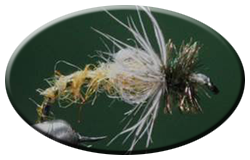THE VEILED PUPA
For approximately 20 years, I have been fishing a fly that my local fly shop (at that time) dubbed "Byron's Soft Hackle". I have always had great success with this fly and so have others who have tried it. The body and thorax of the fly are tied using "Dazzle-Aire" which is a variation of a material often generically called "Sparkle Yarn". I use that material because it was mentioned to me by Gary LaFontaine while I watched him tie one of his Sparkle Pupa patterns in 1992. There are many such materials available and I'm not sure that it matters much which particular brand of an "Antron Yarn" you use. I cut the yarn into 1/2 inch or so lengths and grind them up in a coffee grinder. The thorax was tied very "loosely" or "softly" to allow the fibers there to be exposed and to catch air bubbles. I did this, of course, to try to achieve some of the same results Gary LaFontaine did with his Sparkle Pupa patterns.
The fly has worked extremely well and has landed more fish for me than any other single fly I have used.
The fly is tied on a light, dry fly hook. It is fished primarily across and down as with most soft hackle patterns. The best method of fishing it is to stand in the center of the stream and cast near either bank and then let the current swing the fly across the water and then directly downstream. This way, you quickly cover the entire stream as you slowly work your way downstream. I tie it on a light wire hook for this reason: I am usually fishing this fly when there are no rising fish. If, however, I see a rise, I do a few quick false casts to dry the fly off and gently land it above the rise. The fly will actually float for a little while and is often taken that way by the rising fish.
The fly is most effective in small to medium sized, wadeable streams.

Here is that original pattern - photo by Hans Weilenmann.
Recently, I have been re-reading LaFontaine and others who use various techniques to veil their emerging caddis pupa patterns. The thought crossed my mind that perhaps only the thorax of the fly needs to be veiled to provide the trigger inherent in a fly which tends to capture light and even air bubbles with the antron type materials. This led me to the fly at hand which I call the "Veiled Pupa".

Materials:
- Hook: Light wire dry fly hook. Size 14. In this case, a Gamakatsu S10.
- Abdomen: Your choice of dubbing as to color and fiber material.
- Ribbing: Fine gold Mylar - size 16/18.
- Veil: Any type of "Sparkle Yarn" combed out to separate all fibers.
- Thorax: Your choice of dubbing as to color and fiber material.
- Collar: Natural Partridge.
- Head: Peacock Herl.

Step 1
Tie in the Mylar at approximately the half-way point of the hook shank. The Mylar I use has gold on one side and silver on the other. I find that tying it with the silver side facing you allows the gold side to be exposed when spiraling it over the abdomen.
I tie the Mylar well into the bend of the hook. Given the space requirements and the other materials at the front of the fly, I need the extra length for the abdomen.

Step 2
Dub the abdomen to approximately the half-way point of the hook shank. I dub it with a slight conical shape, but when you rib the fly, most of that will be lost.

Step 3
Rib the fly with the Mylar. I take one or two turns behind the dubbing to serve as the tag.

Step 4
Fluff a length of your "Sparkle Yarn" with a comb so that all the individual fibers are separated and it looks like a length of "fluff". Catch the material just ahead of the abdomen on the hook shank and try to ensure that the fibers are encompassing the entire diameter of the hook - easier said than done. Swing the antron material to the rear of the hook.

Step 5
Dub the thorax.


Step 6
Bring the antron material forward over the thorax, fairly tightly. Again, try to ensure that the fibers are 360 degrees around the hook shank, and tie the material off with just a couple light turns of thread. This will allow you to then use a bodkin needle to loosen the fibers so that they form a loose "veil" around the thorax. Then, tighten the material with your thread and clip the excess.

Step 7
Tie in a single partridge feather just ahead of the thorax and wind 1 to 1.5 turns of it and then tie off.

Step 8
Tie down the partridge and remove excess.

Step 9
Tie in peacock herl. Wrap the peacock herl right up against the partridge to ensure the partridge maintains a concave shape around the thorax area. Take a turn or three of the peacock herl forward and tie off.
Whip finish and the fly is completed.
I certainly hope anyone tying these will have great success with them!!!
For more great info, check out:
Beginning Fly Tying | Intermediate Fly Tying | Advanced Fly Tying.
